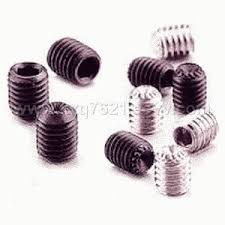02GF74
|
| posted on 18/10/10 at 06:45 PM |

|
|
This week's homework - force to sheer 4 mm socket screw
What would be the force required to sheer a 4 mm socket screw (aka grub screw), tensile strength 14.9.
(I need to see your working out)

in the application below.
there is a rod that is 15 mm diameter (L2) that is iniside a fixed steel tube.
A 4 mm socket screw is fitted between them.
At the other end is a lever, L1, that is 150 mm long.
A twisting force is applied to L1 of 100 kgf, so I reckon force across the socket screw is:
100 x 150 / 7.5 = 2000 kgf
This is applied across the 4 mm socket screw - will the socket screw sheer or not?
(cross section of m4 socket screw is 8.4 mm2)
 
sheer force?
[Edited on 18/10/10 by 02GF74]
|
|
|
|
|
flak monkey
|
| posted on 18/10/10 at 06:54 PM |

|
|
If the bolt in in pure shear and there is no clamping friction to also resist the shear then the shear strength is 0.6 of the tensile strength
Yeild strength of a 12.9 bolt is 1100MPa or 1100N/mm^2, you should be able to work it out from there 
But if not, root diameter of an M4 is 3.141mm, so thats a CSA of 7.7mm^2 so a yeild strength of 8470N or a shear strength of 5082N (518Kg)
Assuming single shear, if its double shear, double the force 
Or if i read the whole thing it would help....
The shear info still stands though. Work in Mpa if you can, its easier
[Edited on 18/10/10 by flak monkey]
Sera
http://www.motosera.com
|
|
|
mad4x4
|
| posted on 18/10/10 at 07:30 PM |

|
|
errrm yeah .... Think so .....
can you also explain E=MC^2
Scot's do it better in Kilts.
MK INDY's Don't Self Centre Regardless of MK Setting !
|
|
|
scudderfish
|
| posted on 18/10/10 at 07:43 PM |

|
|
quote:
Originally posted by mad4x4
errrm yeah .... Think so .....
can you also explain E=MC^2
It can be explained with Pythagoras
http://www.amazon.co.uk/Why-Does-mc2-Brian-Cox/dp/0306819112/ref=sr_1_1?s=books&ie=UTF8&qid=1287430976&sr=1-1

|
|
|
foskid
|
| posted on 18/10/10 at 08:06 PM |

|
|
Easy.....4 white knuckles what else  
|
|
|
iank
|
| posted on 18/10/10 at 08:09 PM |

|
|
http://xkcd.com/179/
--
Never argue with an idiot. They drag you down to their level, then beat you with experience.
Anonymous
|
|
|
perksy
|
| posted on 18/10/10 at 09:46 PM |

|
|
Sorry if i'm being thick but Wouldn't the Hexagon in the middle of the screw 'give out first' ?
|
|
|
02GF74
|
| posted on 19/10/10 at 08:25 AM |

|
|
good observation, you get a gold star - yes it would but it depends on there the hexagonal hollow is in relation to the sheer (or is it shear?) plane
i.e. using a long socket screw with the hollow part sticking out.
[Edited on 19/10/10 by 02GF74]
|
|
|













